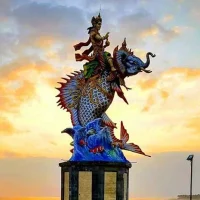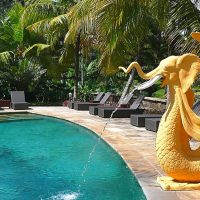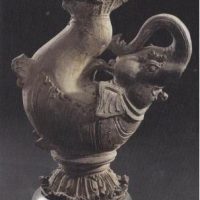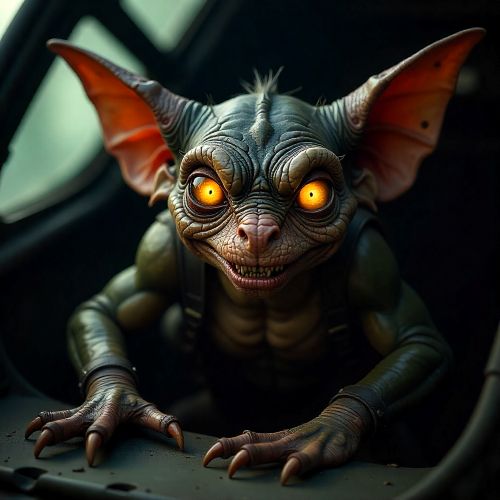Gajah Mina : The Elephant Fish
Listen
At a glance
| Description | |
|---|---|
| Origin | Indonesian Mythology |
| Classification | Hybrids |
| Family Members | N/A |
| Region | Indonesia |
| Associated With | Guardian, Protection |
Gaja Minah
Introduction
Gajah Mina, also known as Gaja Minah, is one of the most captivating mythological creatures in Indonesian and Balinese Hindu tradition. Literally meaning “fish elephant,” the name is derived from the Sanskrit words gajah (elephant) and mina (fish). This hybrid being embodies the perfect harmony between strength and serenity—between the stability of land and the ever-changing nature of the sea. Deeply rooted in the cultural and religious fabric of Bali, Gajah Mina represents protection, balance, and the interconnectedness of all realms. Its presence in temple architecture, ritual art, and Balinese funerary ceremonies reveals its lasting importance as both a spiritual guardian and a cultural symbol.
Physical Traits
The physical form of Gajah Mina is a striking combination of terrestrial power and aquatic grace. It is typically portrayed with the head of an elephant—complete with tusks, a long trunk, and flared ears—symbolizing wisdom, endurance, and divine strength. The body transitions seamlessly into that of a fish, covered in scales with flowing fins and a broad tail designed to glide through the ocean’s depths. In artistic depictions, its form is often adorned with elaborate carvings, colorful pigments, and ornamental jewelry, especially in temple reliefs or ceremonial sculptures. The creature’s composite anatomy serves as a visual metaphor for unity—the coming together of two powerful natural forces: land and water. In Balinese cosmology, this fusion also represents the dual principle of Lingga (masculine, mountain, creation) and Yoni (feminine, sea, fertility), echoing themes of cosmic balance and creation.
Family
Unlike gods or demigods with elaborate genealogies, Gajah Mina does not belong to a specific divine family. Instead, it belongs to a symbolic lineage of hybrid guardians known as Makara—ancient mythological beings found throughout Hindu and Buddhist iconography. The Makara often serves as a vehicle (vahana) for deities like Varuna, the god of the sea, and Ganga, the river goddess. In Bali, Gajah Mina is considered a local manifestation of the Makara archetype, adapted to regional beliefs and marine traditions. Within ceremonial contexts, it functions as a pratima—a sacred emblem or manifestation of divine energy—often linked to the ocean deity Baruna. This association reinforces its protective and purifying qualities, suggesting a spiritual “family” not of blood, but of divine purpose and cosmological significance.
Other names
Throughout Indonesia, Gajah Mina is known by several variations of its name due to linguistic and cultural diversity. Common variants include Gajamina, Gadjamina, Gaja Minah, and Eon, each reflecting regional pronunciation and historical transliteration practices. The term “fish-elephant” is also used in direct translations, preserving the creature’s symbolic identity across languages. However, it is important not to confuse Gajah Mina with Gajah Laut (elephant seal), a distinct term in modern Indonesian referring to real marine mammals. These varied names demonstrate how Gajah Mina has been localized across different Balinese and Javanese communities while maintaining its sacred meaning and mythological essence.
Powers and Abilities
Gajah Mina’s mythic powers are deeply connected to protection, purification, and safe passage. In Balinese seafaring and ritual life, the creature is revered as a divine guardian who shields sailors from storms and malevolent sea spirits. Fishermen historically offered small sacrifices or symbolic tributes to Gajah Mina before embarking on voyages, invoking its blessings for safety and abundance. In funerary contexts, Gajah Mina assumes a profoundly spiritual role: sarcophagi shaped like the creature, known as patulangan Gajah Mina, are used during royal or high-caste cremation ceremonies. These elaborately carved coffins represent the soul’s vessel as it travels from the physical world to the spiritual realm, emphasizing transformation, release, and purification.
The creature also embodies liminal power—guarding thresholds where land meets sea and life meets death. As part of temple architecture, Gajah Mina statues are often positioned at gateways or entrances, serving as sentinels that repel evil forces and preserve sacred purity within temple grounds. In symbolic terms, its vigilant eyes, formidable tusks, and aquatic agility reflect both the strength to confront darkness and the insight to navigate between worlds.
Modern Day Influence
In contemporary Bali and Indonesia, Gajah Mina continues to flourish as both a cultural icon and artistic inspiration. Its most prominent modern representation is the monumental Gajah Mina statue at Pererenan Beach in Mengwi, a popular coastal landmark that merges mythological artistry with public symbolism. Standing tall against the ocean, the statue is a reminder of Bali’s spiritual relationship with nature and the enduring link between myth and environment.
Gajah Mina’s image also appears frequently in traditional art forms such as wood carvings, metal sculptures, and temple reliefs. Many Balinese fishing boats, known as jukung, are decorated with brightly painted Gajah Mina motifs, believed to endow protection and ensure safe passage across the seas. In temples, the creature adorns gates, shrines, and ritual platforms, marking its continued importance in daily religious life.
In recent years, Gajah Mina has transcended its ritual context to inspire modern artists, environmental activists, and cultural heritage projects. Contemporary Balinese artisans use the figure to promote ecological awareness, seeing its hybrid form as a metaphor for the balance between humanity and nature. Exhibitions and local festivals often feature Gajah Mina sculptures made from recycled materials, highlighting the intersection of mythology, sustainability, and cultural continuity.
Furthermore, scholars and cultural historians increasingly recognize Gajah Mina as a key element of Indonesia’s mythological heritage. It is studied alongside other hybrid beings like Singha Barong and Garuda for its symbolic representation of cosmic order and transformation. In tourism, Gajah Mina has become a recognizable emblem of Balinese identity, featured in hotels, logos, and art galleries that celebrate traditional mythology through modern aesthetics.
Related Images
Source
Wikipedia contributors. (2015, August 3). Gajamina. Wikipedia. https://en.wikipedia.org/wiki/Gajamina
Cryptid Wiki. (2018, December 31). Gajah Mina. https://cryptidz.fandom.com/wiki/Gajah_Mina
BigBogBali. (2019). Pererenan Beach Statue Gajah Mina in Mengwi Bali. https://www.bigbogbali.com/2019/10/pererenan-beach-statue-gajah-mina.html
NatureRules1 Wiki. (n.d.). Gajah Mina. Fandom. https://naturerules1.fandom.com/wiki/Gajah_Mina
Facebook group Austronesian languages. (n.d.). Origin and meaning of gaja-mina in Austronesian languages. https://www.facebook.com/groups/austronesian.languages/posts/1489339705322373/
Instagram. (2025, January 1). GAJAH MINA in Hindu belief. https://www.instagram.com/p/DEHbFGmyGWK/?hl=en
Eiseman, F. B. (1990). Bali: Sekala and Niskala. Periplus Editions.
Covarrubias, M. (1937). Island of Bali. Alfred A. Knopf.
Hobart, A., Ramseyer, U., & Leeman, A. (1996). The People of Bali. Blackwell Publishers.
Geertz, C. (1973). The Interpretation of Cultures. Basic Books.
Lansing, J. S. (2006). Perfect Order: Recognizing Complexity in Bali. Princeton University Press.
Frequently Asked Questions
What is lorem Ipsum?
I am text block. Click edit button to change this text. Lorem ipsum dolor sit amet, consectetur adipiscing elit. Ut elit tellus, luctus nec ullamcorper mattis, pulvinar dapibus leo.
What is lorem Ipsum?
I am text block. Click edit button to change this text. Lorem ipsum dolor sit amet, consectetur adipiscing elit. Ut elit tellus, luctus nec ullamcorper mattis, pulvinar dapibus leo.
What is lorem Ipsum?
I am text block. Click edit button to change this text. Lorem ipsum dolor sit amet, consectetur adipiscing elit. Ut elit tellus, luctus nec ullamcorper mattis, pulvinar dapibus leo.
What is lorem Ipsum?
I am text block. Click edit button to change this text. Lorem ipsum dolor sit amet, consectetur adipiscing elit. Ut elit tellus, luctus nec ullamcorper mattis, pulvinar dapibus leo.
What is lorem Ipsum?
I am text block. Click edit button to change this text. Lorem ipsum dolor sit amet, consectetur adipiscing elit. Ut elit tellus, luctus nec ullamcorper mattis, pulvinar dapibus leo.









